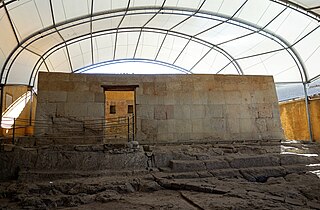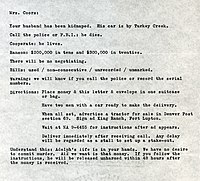
A hostage is a person seized by an abductor in order to compel another party, one which places a high value on the liberty, well-being and safety of the person seized—such as a relative, employer, law enforcement, or government—to act, or refrain from acting, in a certain way, often under threat of serious physical harm or death to the hostage(s) after expiration of an ultimatum. The Encyclopædia Britannica Eleventh Edition defines a hostage as "a person who is handed over by one of two belligerent parties to the other or seized as security for the carrying out of an agreement, or as a preventive measure against certain acts of war."

The First Barbary War (1801–1805), also known as the Tripolitan War and the Barbary Coast War, was a conflict during the Barbary Wars, in which the United States and Sweden fought against Tripolitania. Tripolitania had declared war against Sweden and the United States over disputes regarding tributary payments made by both states in exchange for a cessation of Tripolitatian commerce raiding at sea. United States President Thomas Jefferson refused to pay this tribute. Sweden had been at war with the Tripolitans since 1800. The First Barbary War was the first major American war fought outside the New World, and in the Arab world.

The Ransom Room is a small building located in Cajamarca, Peru. It is considered to be the place where the Inca Empire came to an end with the capture and eventual execution of the Inca Emperor Atahualpa.

The Perdicaris affair, also known as the Perdicaris incident, refers to the kidnapping of Greek-American Ion Hanford Perdicaris (1840–1925) and his stepson, Cromwell Varley, a British subject, by Ahmed al-Raisuni and his bandits on 18 May 1904 in Tangier, Morocco. Raisuni, leader of several hill tribes, demanded a ransom of $70,000, safe conduct, and control of two of Morocco's wealthiest districts from the Sultan of Morocco Abd al-Aziz. During lengthy negotiations, he increased his demands to control of six districts. The historical importance of the affair lay not in the kidnapping itself but in the concentration of naval power in Tangier and what it meant for the politics of gunboat diplomacy.
Members of the Iraqi insurgency began taking foreign hostages in Iraq beginning in April 2004. Since then, in a dramatic instance of Islamist kidnapping they have taken captive more than 200 foreigners and thousands of Iraqis; among them, dozens of hostages were killed and others rescued or freed. In 2004, executions of captives were often filmed, and many were beheaded. However, the number of the recorded killings decreased significantly. Many hostages remain missing with no clue as to their whereabouts. The United States Department of State Hostage Working Group was organized by the U.S. Embassy, Baghdad, in the summer of 2004 to monitor foreign hostages in Iraq.
On 6 October 1972, at a one-teacher school in the rural town of Faraday in Victoria, Australia, two plasterers, Edwin John Eastwood and Robert Clyde Boland, kidnapped six female pupils and their teacher for a $1,000,000 ransom. The Victorian government claimed it would pay the ransom. The victims escaped and the criminals were captured, tried and convicted. Eastwood escaped and later kidnapped a teacher and nine pupils. He was again captured, convicted and sentenced. While in prison, Eastwood strangled convicted rapist Glen Davies in what was ruled self-defence. He was eventually released, having served his sentence.
Gabriele Kröcher-Tiedemann (1951–1995) was a German far-left militant, associated with the Movement 2 June (J2M) and the Red Army Faction. She married Norbert Kröcher in 1971 and later divorced him whilst she served a prison sentence. She was freed by the kidnapping of Peter Lorenz in 1975, then participated in the OPEC siege. In 1977, she was arrested in Switzerland after shooting two policemen. She was imprisoned until 1991 and died in 1995.

Cilician pirates dominated the Mediterranean Sea from the 2nd century BC until their suppression by Pompey in 67–66 BC. Because there were notorious pirate strongholds in Cilicia, on the southern coast of Asia Minor, the term "Cilician" was long used to generically refer to any pirates in the Mediterranean.

On 19 July 2007, a group of 23 South Korean missionaries were captured and held hostage by members of the Taliban while passing through Ghazni Province of Afghanistan. The group, composed of sixteen women and seven men, was captured while traveling from Kandahar to Kabul by bus on a mission sponsored by the Saemmul Presbyterian Church. The crisis began when two local men, who the driver had allowed to board, started shooting to bring the bus to a halt. Over the next month, the hostages were kept in cellars and farmhouses and regularly moved in groups of three to four.
Piracy off the coast of Somalia occurs in the Gulf of Aden, Guardafui Channel, and Somali Sea, in Somali territorial waters and other surrounding places and has a long and troubled history with different perspectives from different communities. It was initially a threat to international fishing vessels during the early 2000s, only to rapidly escalate and expand to international shipping during the War in Somalia (2006–2009).
On September 2, 2008, the French yacht Carré d'As IV and its two crew were captured in the Gulf of Aden by seven armed Somali pirates, who demanded the release of six pirates captured in the April MY Le Ponant raid and over one million dollars in ransom. On September 16, 2008, on the orders of President Nicolas Sarkozy, French special forces raided and recovered the yacht, rescued the two hostages, killed one pirate, and captured the other six. The pirates were flown to France to stand trial for piracy and related offenses; ultimately, five of them were convicted and sentenced to four to eight years in prison, while a sixth was acquitted. The incident marked the second French counter-piracy commando operation of 2008, as well as the first French trial of Somali pirates.
The following is a list of known foreign hostages captured in Somalia, particularly since the start of the Ethiopian intervention and the 2009–present phase of the civil war.

Crossing the inner German border remained possible throughout the Cold War; it was never entirely sealed in the fashion of the border between the two Koreas, though there were severe restrictions on the movement of East German citizens. The post-war agreements on the governance of Berlin specified that the Western Allies were to have access to the city via defined air, road, rail and river links. This was mostly respected by the Soviets and East Germans, albeit with periodic interruptions and harassment of travellers. The worst disruption to this was in 1948 during the Berlin Blockade when supplies could only be brought in by air – the famous Berlin Airlift – although Allied military convoys could pass through East Germany en route to Berlin.
The 2003 Sahara hostage crisis concerns the events surrounding the abduction of 32 European tourists in seven separate groups in the Algerian Desert in 2003. They were released in two groups: one in Algeria and the other from neighbouring Mali, several months later.
MV Hansa Stavanger was a German container ship. The owner of the ship was Schiffahrts-Gesellschaft MS "HANSA STAVANGER" Co. KG. The Hansa Stavanger was built in 1997 at Guangzhou Wenchong Shipyard in the Chinese city of Guangzhou. Her loading capacity is 20,526 GT & she could transport 1,550 containers on board. She was captured by Somali pirates on 4 April 2009. Around 1 May 2009, USS Boxer and a screen of German Navy warships assisted approximately 200 members of the German special police unit GSG-9 in approaching the hijacked ship. During the last phase of the operation, James L. Jones, the U.S. President's National Security Advisor, withheld final approval for the operation out of concern for the safety of the 25 sailors aboard the vessel. This led the German Federal Ministry of Defence to abort the planned attack on the freighter and the GSG-9 unit returned to their base of operations at the airport of Mombasa, Kenya.
The 2000 Sipadan kidnappings was a hostage crisis in Sabah, Malaysia, and the southern Philippines that began with the seizing of twenty-one hostages from the dive resort island of Sipadan at approximately 6:15 p.m. on 23 April 2000, by up to six Abu Sayyaf (ASG) bandits. Taken hostage were 10 tourists from Europe and the Middle East and 11 Malaysian resort workers, 19 non-Filipino nationals in total. The hostages were taken to an Abu Sayyaf base in Jolo, Sulu.

The hijacking of Lufthansa Flight 649 was an aircraft hijacking that took place between 22 and 23 February 1972. Eventually, all hostages on board the seized Boeing 747-230B were released when the West German government paid a ransom of US$5 million.
The Claustre Affair was a hostage crisis during the First Chadian Civil War. Chadian rebels, calling themselves the Command Council of the Armed Forces of the North (CCFAN), led by Hissène Habré kidnapped Françoise Claustre, a French archaeologist, Marc Combe, a worker in a French development organization in Chad, and Christoph Staewen, a German doctor. Although Combe escaped and Staewen was ransomed back by the West German government, the rebels demanded a ransom of 10 million francs for Mrs. Claustre and her husband Pierre, who was later also captured by the rebels. The case garnered international attention, with the French sending a negotiator who was later executed. Finally the French appealed to Muammar Gaddafi to free the hostages, which he then did. The affair showcased Libya's growing influence in Central Africa.

The kidnapping of Ursula Herrmann was a notorious child kidnapping which occurred in Germany on 15 September 1981 in which a 10-year-old girl disappeared while riding a bicycle to her home. The child was subsequently found dead in a rectangular wooden box buried in woodland.
Piracy kidnappings occur during piracy, when people are kidnapped by pirates or taken hostage. Article 1 of the United Nations International Convention against the Taking of Hostages defines a hostage-taker as "any person who seizes or detains and threatens to kill, to injure, or to continue to detain another person in order to compel a third party namely, a State, an international intergovernmental organization, a natural or Juridical person, or a group of people, to do or abstain from doing any act as an explicit or implicit condition tor the release of the hostage commits the offense of taking of hostages ("hostage-taking") within the meaning of this convention." Kidnappers often try to obtain the largest financial reward possible in exchange for hostages, but piracy kidnappings can also be politically motivated.











